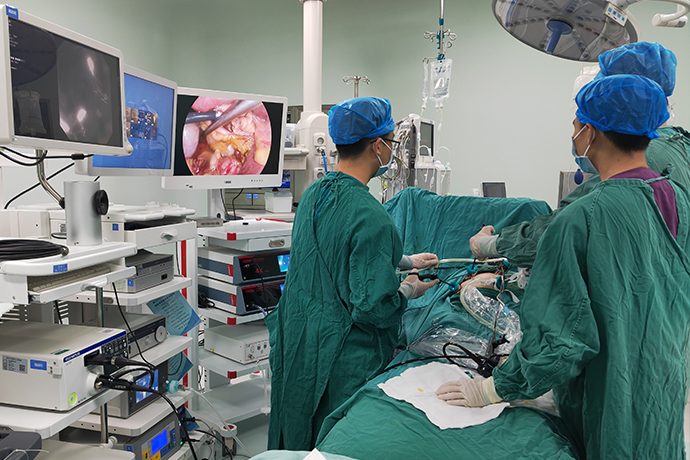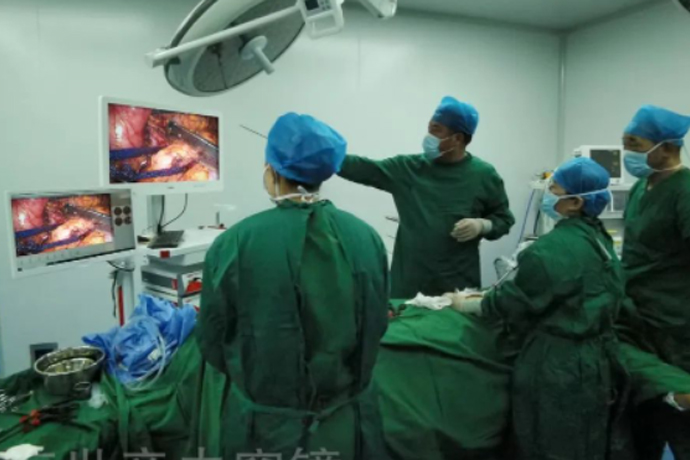[Laparoscopy in Hepatobiliary Surgery] Tumors of Pancreatic Body and Tail
Release time: 25 Apr 2023 Author:Shrek
The main symptoms
Tumors of the tail of the pancreas grow in the tail of the pancreas, and the early typical clinical manifestations are pancreatic body cancer and tail cancer. Early non-specific symptoms such as upper abdominal discomfort, weight loss, anorexia, and abdominal distension are often misdiagnosed as other diseases such as gastritis, and the diagnosis of pancreatic cancer is ignored. The patient is obviously thin in a short period of time, and sudden diabetes should be alert to the existence of pancreatic body cancer and tail cancer. Once the patient has persistent low back pain, or the tumor is palpable in the abdomen, the tumor has advanced to an advanced stage.

1. Abdominal pain is the main symptom of pancreatic cancer. No matter where the cancer is located, such as the head or the tail of the body, there will be pain. In addition to the pain in the middle abdomen, left upper abdomen, and right upper abdomen, a few cases will also have pain around the umbilicus and the entire abdomen in the left and right lower abdomen. There will be testicular pain, which may also be confused with other diseases.
2. Jaundice, jaundice is obstructive, often accompanied by dark yellow urine, and clay-like stools are caused by the violation or compression of the lower end of the common bile duct. Jaundice is progressive, although there may be slight fluctuations, it is impossible to completely Regression, the temporary relief of jaundice is related to the resolution of the inflammation around the ampulla in the early stage, and the jaundice caused by the tumor invading the lower end of the common bile duct and entrusted to the ampulla is more likely to fluctuate in the late stage.
3. Some gastrointestinal symptoms, the most common one is loss of appetite, which is actually nausea and vomiting, constipation or even melena, diarrhea, often refers to steatorrhea, loss of appetite, and the lower end of common bile duct and pancreatic duct are blocked by tumor, bile and pancreatic juice cannot into the duodenum.
Traditional surgery
For tumors located in the body and tail of the pancreas, that is, the tumors at C, D, and E shown in the figure, the previous surgical method is to directly choose the body and tail of the pancreas + splenectomy, that is to say, the CDE and the spleen are all removed together. .
Why cut the spleen? You can see from the picture that the red arrow marks the splenic artery, and the blue arrow marks the splenic vein. They are close to the back of the pancreas, so it is very easy to damage and cause massive bleeding when the pancreas is removed. Therefore, during the operation Surgeons often choose to ligate and break them directly, so that the operation becomes relatively easy and the risk is much smaller. But in this way, the patient also lost the spleen, which was not a problem at all.
Spleen-preserving surgery for tail of pancreas
In order to solve this problem, the spleen-preserving operation of the body and tail of the pancreas under the laparoscope can achieve the effect of only resecting the diseased pancreas while keeping the spleen intact under the condition of ensuring safety by taking advantage of the fine operation of the laparoscope and the advantages of magnified field of view, thereby greatly improving the Improve the long-term quality of life and psychological burden of patients after surgery.
Of course, the anatomical structure during the actual operation is much more complicated than that shown in the schematic diagram, so whether the spleen can be preserved or not depends on the final decision of the surgeon according to the intraoperative situation.
Surgical steps
1. Supine position, the left splenic flexure is elevated.
2. Abdominal puncture and catheterization, enter the laparoscope for exploration.
3. Open the gastrocolic ligament to expose the pancreas.
4. Free the pancreas and cut it off.
5. Dissection and dissociation of splenic vessels.
6. Completely dissect the body and tail of the pancreas and take out the specimen.
7. The pancreatic stump was further sutured and embedded to stop bleeding.
8. Flush the abdominal cavity and place a drainage tube.
9. Close the puncture holes in the abdomen.
Common problem
What are the technical key points of laparoscopic pancreatectomy?
There are three technical difficulties in laparoscopic distal pancreatectomy: finding the splenic artery through the superior border of the gland approach, finding the splenic vein through the inferior border of the pancreas approach, and controlling bleeding. The most critical technique in all laparoscopic procedures is control of bleeding. The key to controlling bleeding in laparoscopic total and tail pancreatectomy with spleen preservation is to control bleeding from the splenic artery and vein; the key to control bleeding in laparoscopic total and tail pancreatectomy without spleen preservation is to first ligate the splenic artery and properly handle the splenic pedicle and short gastric vessels .
What are the surgical approaches for laparoscopic resection of the free pancreas? What is their role?
Approach to the upper edge of the pancreas: look for the splenic artery.
Inferior border approach to the pancreas: look for the splenic vein.
Pancreatic tail approach: expose the splenic hilus and splenic pedicle blood vessels.
What is the principle of converting laparoscopic body and tail pancreatectomy to laparotomy? What are the main reasons for conversion to laparotomy?
The principle of converting laparoscopic pancreatectomy to laparotomy is "life safety first, minimally invasive technique second". When minimally invasive surgery endangers the patient's life safety or may cause serious complications, it must be converted to laparotomy immediately. Conversion to laparotomy is not a failure of the operation, but a continuation of the operation, and achieving the purpose of treatment is the sign of a successful operation.
Common reasons for conversion to laparotomy include:
1. When entering the abdominal cavity for exploration, the location of the tumor cannot be determined.
2. The tumor is closely related to important blood vessels in the abdominal cavity, such as the superior mesenteric artery and vein, common hepatic artery, etc., which are easily damaged and lead to uncontrollable massive bleeding.
3. The tumor has metastasized to distant places, and it needs to be combined with resection of other organs and lymph node dissection.
4. Severe adhesions in the abdominal cavity revealed that it was difficult to separate the pancreas.
5. Uncontrollable massive bleeding occurred during the operation.
6. Damage to important organs is difficult to repair under laparoscopy.
